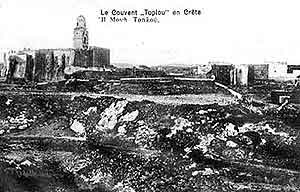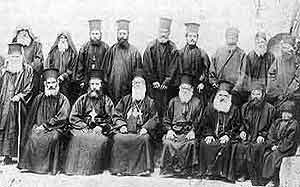There is some doubt about, when exactly the monastery was built. According to tradition the monastery was built, after some local farmers in the 15th century found a Panagia icon in a cave. There had earlier been another monastery to Agios Isidoros, which the Latin monk C. Buondelmonti visited in 1415 during his journey to Crete.

The well-known archaeologist and historian Stefanos Xanthoudidis considers that the monastery was founded about 1600, but considers it subsequently most likely that the older monastery to Agios Isidoros from Byzantine time was situated in exactly this place, and that the then abbot Gavriil Pantogalos renovated it under the name of Panagia Akrotiriani. In any case there are written confirmations of the existence of the monastery from 1611, where Andreas Kornaros in his will left a big amount of money to the monastery.
Old postcard with Toplou
There are many examples of bishoprics and monasteries being moved further into the country to avoid attacks from the pirates, who in the last part of the Venetian period (1210-1669) ravaged the coasts of Crete, and it fits very well in with the position of Toplou, which can not be seen from the sea.
In a Venetian document from 1613 the monastery is mentioned under the name of Akrotiriani. The document furthermore mentions that the monastery was fortified to protect the monks in case of attacks, but because it had suffered great damage during the heavy earthquake in 1612, abbot Gavriil Pantogalos applied for help to renovate it. The Senate in Venice granted a sum of 200 ducats because many of our citizens go to church in this kingdom, as it is written in the document. It was during this renovation that the monastery got its fortress-like appearance with the tall closed wall, which completely separates the interior of the monastery from the surroundings. Subsequently with the amount of money, the Venetians gave the monastery the right to have soldiers and a cannon in order to defend itself against the growing pressure from the Ottoman Empire.
After the Turks in 1648 conquered the eastern part of Crete, 40 Muslim monks with their leader Chorasanli Ali Baba visited the monastery, where they were housed and fed. (Chorasanli Ali Baba later founded a Muslim monastery in the present Ampelokipi, a suburb of Iraklion.) They were so satisfied with the treatment they were given that Ali Baba ordered a turban of white marble to be made above the entrance of the monastery, a symbol of respect and defence against the janizaries. These soldiers made up the core of the Ottoman sultan's army in the period 1329-1826. They were chosen among the Christian children and had a severe Islamic upbringing in order to mature them for a lifelong service as elite soldiers. History has shown a great many examples of their arbitrariness and harshness towards the local people.
In 1828 the Turks fled from Sitia to the monastery, where they fortified themselves to avoid the revolutionary Cretans, who wanted to punish them for their crimes. But when the Turks heard about the fate, their fellow-countrymen had suffered in Lithines about 20 km further south, they surrendered. At that time Lithines had a fortification with a three-storey tower, where the local Turks (140 armed men and 250 women and children) had barricaded themselves. But the leader of the revolutionaries, G. Tsouderos set the tower on fire, and they all perished. Today there are no traces left of the fortification.
When the rebellion had been suppressed, Toplou Monastery was re-inhabited, but as early as in 1866 it was again exposed to an attack because of abbot Meletios Michelidakis' participation in the Revolutionary Council. During the following revolutions no harm was done to the monastery, even though it had became a refuge for the Christians.

During World War II the monastery became of great importance to the Resistance, because it had a wireless radio to its disposal. Unfortunately the Germans got wind of it, so they took abbot Gennadios Silignakis and two monks (Evmenios Stamatakis and Kallinikos Papathanasakis) prisoner. Stamatakis died in prison after having been tortured. The other two were executed in Agia at Chania, after the bishop of the area vainly had tried to have them reprieved.
The monks at the beginning of the 20th century
Toplou as a school
In several of the monastery's old manuscripts the monks have described the historical events they wanted to save for the time to come. They wrote among other things that the monastery during the Turkish period organized schooling. The English commander T.A.B. Spratt, who visited Toplou in 1850, also tells us that a school with 30 pupils was working: A school is attached to this monastery, at which about thirty lads of the district receive gratuitous education.